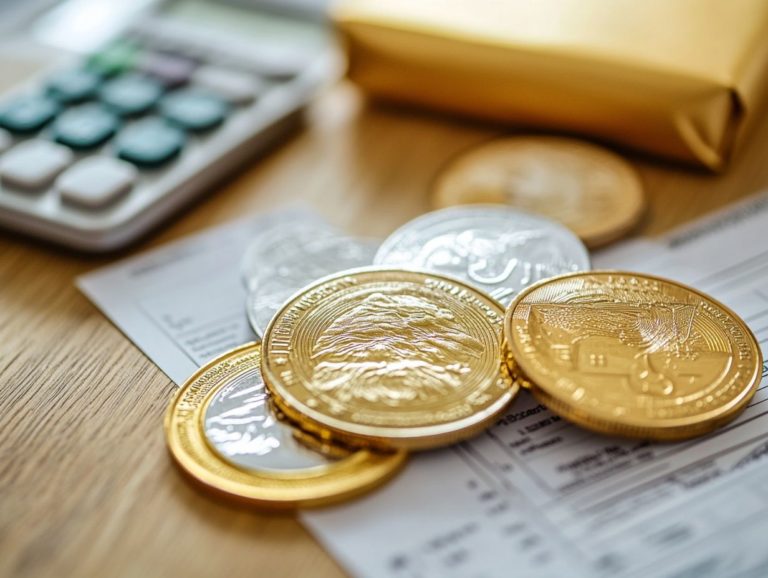How to Conduct a Tax Review of Your Precious Metals Portfolio
Ready to unlock the secrets of tax savings on your precious metals investments? Investing in precious metals can be highly rewarding, but it also carries tax implications that you should fully understand.
This guide delves into the various aspects of taxation on precious metals, including how to perform a comprehensive tax review of your portfolio.
Discover strategies to minimize your tax burden, the benefits of collaborating with a tax professional, and key compliance tips to keep in mind. Don’t miss out on potential savings!
Whether you’re a seasoned investor or just beginning your journey, grasping these factors can empower you to maximize your returns and remain well-informed.
Contents
- Key Takeaways:
- Know Your Precious Metals Tax Implications
- Conducting a Tax Review of Your Precious Metals Portfolio
- Strategies for Reducing Tax Burden
- Working with a Tax Professional
- Staying Compliant with Tax Laws
- Frequently Asked Questions
- What is a tax review of a precious metals portfolio?
- Why is it important to conduct a tax review of my precious metals portfolio?
- When should I conduct a tax review of my precious metals portfolio?
- What information do I need to conduct a tax review of my precious metals portfolio?
- What should I do if I discover any errors or discrepancies in my tax review?
- Are there any tax benefits or incentives for owning precious metals in my portfolio?
Key Takeaways:
- Understand the tax implications to avoid surprises.
- Conduct a thorough review of your portfolio to assess potential tax liabilities.
- Explore strategies to maximize deductions and reduce your tax burden.
Know Your Precious Metals Tax Implications
Understanding the tax implications of your investments in precious metals like gold and silver is crucial for navigating the complexities of taxes on profits from selling assets. These metals—gold, silver, platinum, and palladium—can enhance your diversified investment portfolio.
The tax responsibilities tied to buying, selling, and storing these assets can be quite complex, varying significantly based on the type of transaction and your holding period. Taxation can directly affect your profits and losses, and it’s worth exploring potential exemptions that may apply depending on your individual circumstances and IRS regulations.
Overview of Taxation on Precious Metals
Taxation on precious metals like gold and silver can be quite intricate, varying based on how they’re classified and the nature of the transaction. It’s essential for you to grasp the different capital gains tax rates set by the IRS.
The IRS treats precious metals investments distinctly from traditional securities, leading to specific tax implications that could significantly impact your investment strategy. For example, long-term capital gains on precious metals are typically taxed at a maximum rate of 28%, which is notably less favorable than the rates for stocks and bonds.
When you report these assets, you need to consider not only the type of investment—whether it’s bullion or coins—but also how frequently and how much you’re trading. This distinction is particularly critical, as it can directly affect how your investments are treated concerning tax liability and the rules you need to follow.
Conducting a Tax Review of Your Precious Metals Portfolio
Conducting a tax review of your precious metals portfolio is essential for grasping your financial position and ensuring compliance with IRS regulations, especially concerning capital gains, losses, and reporting requirements.
You need to account for your holdings in gold, silver, and other precious metals, carefully evaluating both profits and losses throughout the investment period. A thorough review not only clarifies potential tax liabilities but also uncovers opportunities for strategic financial planning and loss carryforward, elevating your overall investment management.
Gathering Necessary Information
Gathering the necessary information for your tax review of your precious metals portfolio requires you to compile detailed records of all transactions, appraisals, and current market values to ensure accurate reporting to the IRS.
You should diligently maintain various types of documentation, such as purchase receipts that serve as proof of acquisition and transaction records that outline every buy and sell. Appraisals are essential for assessing current market value, allowing you to track how the worth of your investments has shifted over time.
By keeping this information organized, you can more effectively calculate potential profits and losses, particularly when it comes to capital gains calculations. Accurate valuations are crucial because they directly influence your tax obligations and overall financial performance, paving the way for a smoother tax filing experience.
Assessing Potential Tax Liabilities
Assessing potential tax liabilities related to your precious metals investments is a crucial step in your financial planning journey. This process allows you to make informed decisions based on capital gains and losses as outlined by the IRS.
By carefully examining both short-term and long-term capital gains, you can gain valuable insights into how these factors influence your overall tax obligations. Short-term gains are typically taxed at higher rates compared to long-term gains. This knowledge equips you to strategically manage your investment timelines.
Identifying losses that qualify for tax deductions can significantly reduce your taxable income. Techniques like tax-loss harvesting—selling losing investments to reduce taxes—can maximize these deductions. Maintaining accurate reporting ensures compliance with IRS requirements and safeguards you against potential audits and penalties.
Strategies for Reducing Tax Burden
Implementing effective strategies to reduce your tax liability on precious metals investments can greatly enhance your overall financial health. By doing so, you can maximize deductions and credits while taking full advantage of tax-advantaged accounts, positioning yourself for greater financial success.
Maximizing Deductions and Credits
Maximizing deductions and credits is crucial for reducing your tax liability on precious metals investments. These strategies offer valuable opportunities to lower taxable income and enhance your financial returns.
Become well-acquainted with the various tax benefits available, such as a tax break for selling collectibles and potential write-offs for investment-related expenses. By properly documenting your purchases, storage fees, and educational costs, you can qualify for deductions that strengthen your overall financial strategy.
Grasping the IRS regulations surrounding the sale and exchange of precious metals will enable you to navigate the complexities of reporting profits and losses. Use these advantages smartly to cut taxes and boost your returns!
Utilizing Tax-Advantaged Accounts
Utilizing tax-advantaged accounts such as a precious metal IRA offers significant benefits if you’re aiming to hold gold and silver while minimizing tax implications.
These accounts are tailored for a long-term investment strategy. They allow you to allocate funds toward qualifying precious metals, including gold, silver, platinum, and palladium. Stay informed about annual contribution limits. This knowledge helps maximize your tax-deferred investments each year.
These accounts provide tax deferral on capital gains, enhancing your potential for wealth accumulation over time. They also act as a safeguard against economic volatility. By diversifying your portfolio with tangible assets like precious metals, you can strengthen your financial security and resilience for the future.
Working with a Tax Professional
Engaging a tax professional can offer invaluable advantages as a precious metals investor. Their expertise can guide you through the intricate landscape of IRS regulations, ensuring you navigate compliance with confidence.
They can also help you optimize tax strategies tailored to your unique investment profile, maximizing your potential returns and safeguarding your interests.
Start your journey to smarter tax strategies today! Consult a tax professional to unlock your potential!
Benefits and Considerations
Working with a tax professional offers tailored strategies and insights into IRS rules. Keep in mind the costs involved and choose someone experienced in precious metals.
This specialized knowledge streamlines your tax planning, which means organizing your financial activities to minimize tax payments. A seasoned tax advisor is someone with extensive experience in tax matters.
When evaluating the cost of these services, weigh the fees against potential tax savings and peace of mind. It’s crucial to assess a tax professional’s credentials and experience in precious metals, as their expertise can significantly influence your investment returns.
In summary, collaborating with a tax professional can lead to significant savings through various deductions and credits they identify for you.
Staying Compliant with Tax Laws
For precious metals investors, maintaining compliance with tax laws is essential. This requires a thorough understanding of IRS regulations, reporting requirements, and crucial deadlines.
By familiarizing yourself with these elements, you can avoid penalties and ensure your financial reporting is precise and reliable.
Important Tax Filing Deadlines
Important tax filing deadlines set by the IRS provide a structured framework for you as a precious metals investor to accurately report your transactions and steer clear of unnecessary penalties.
These deadlines dictate when you need to submit Forms 1040 and 1099-B, playing a vital role in ensuring compliance and protecting your financial integrity. For example, Form 1040, essential for individual income tax reporting, typically has an annual deadline of April 15. Meanwhile, Form 1099-B, detailing your sales of precious metals, is generally due to recipients by January 31.
Missing these critical deadlines can result in hefty penalties, interest on unpaid taxes, and unwanted scrutiny from the IRS. Don’t risk penalties! Stay organized and mark those key dates on your calendar. Maintain meticulous records throughout the year and proactively seek professional guidance to navigate any complexities in your filings.
Frequently Asked Questions
What is a tax review of a precious metals portfolio?
A tax review of a precious metals portfolio is the process of examining the tax implications and obligations associated with owning and trading precious metals, such as gold, silver, and platinum, in your investment portfolio.
Why is it important to conduct a tax review of my precious metals portfolio?
Conducting a tax review of your precious metals portfolio can help ensure that you are in compliance with tax laws and regulations. It can also help you identify potential tax savings or deductions.
When should I conduct a tax review of my precious metals portfolio?
It is recommended to conduct a tax review of your precious metals portfolio on an annual basis or whenever you make significant changes, such as buying or selling large quantities of precious metals.
What information do I need to conduct a tax review of my precious metals portfolio?
You will need to gather information such as purchase and sale dates, quantities, and prices of your precious metals, along with any associated fees or expenses.
What should I do if I discover any errors or discrepancies in my tax review?
If you find any errors or discrepancies in your tax review, it is important to consult with a tax professional to address and correct them as soon as possible.
Are there any tax benefits or incentives for owning precious metals in my portfolio?
Yes, there are certain tax benefits and incentives available for owning precious metals, such as tax-deferred accounts or deductions for capital losses. However, it is important to consult with a tax professional for specific guidance on your individual situation.



















